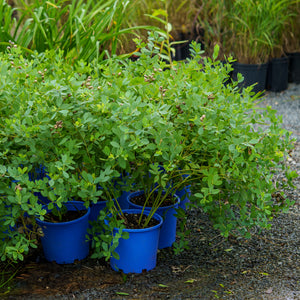The Baptisia Guide
Baptisia, commonly known as False Indigo, is a long-lived, low-maintenance perennial prized for its spires of pea-like flowers and attractive foliage. Native to North America, Baptisia is a tough and adaptable plant that thrives in a variety of garden settings. With blooms in shades of blue, purple, yellow, and even pink, these drought-tolerant perennials provide a stunning display in late spring and early summer. Here’s everything you need to know about growing and caring for Baptisia.
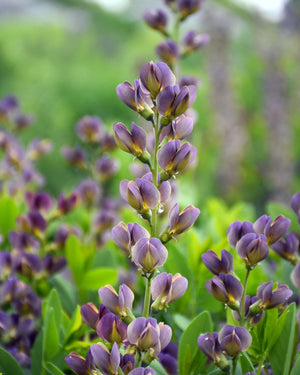
About
Baptisia belongs to the Fabaceae (legume) family and is valued for its striking flowers, robust growth, and ability to improve soil fertility through nitrogen fixation. It is a staple in native plant gardens, prairie plantings, and low-maintenance landscapes due to its deep-rooted, drought-tolerant nature.
Popular varieties include Baptisia australis, the classic blue False Indigo; Baptisia 'Lemon Meringue', with bright yellow blooms; and Baptisia 'Purple Smoke', which features dusky purple flowers with smoky stems. Newer hybrids such as Baptisia 'Pink Lemonade', Baptisia 'Blueberry Sundae', and Baptisia 'Twilite Prairieblues' expand the color palette, offering garden designers more options.
Baptisia plants form impressive clumps over time, with sturdy, shrub-like growth that remains attractive even after flowering. The black seed pods that develop in late summer add further ornamental interest and are often used in dried arrangements.
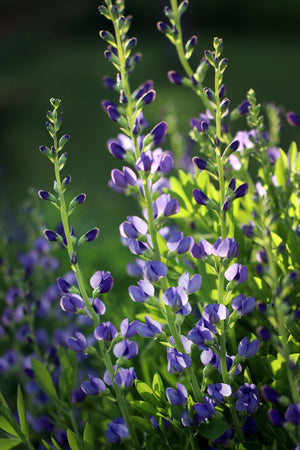
PLANTING
- USDA Hardiness Zones: Most Baptisia varieties thrive in Zones 4-9, offering excellent cold and heat tolerance.
- Soil: Prefers well-drained, sandy, or loamy soil. It thrives in nutrient-poor soil and does not require heavy fertilization.
- Sunlight: Full sun (at least 6 hours per day) is best for strong flowering and sturdy growth. Tolerates light shade but may bloom less.
- Watering: Drought-tolerant once established. Water regularly during the first growing season to help roots develop.
- Spacing: Space plants 3-4 feet apart, as Baptisia forms large, shrub-like clumps over time.
- Planting Time: Seeds - Direct sow in fall for natural stratification or cold stratify for 8-10 weeks before spring planting. Transplants - Plant in spring or fall when temperatures are mild to encourage strong root establishment.
To plant Baptisia, loosen the soil and mix in compost if needed. Dig a hole twice as wide as the root ball, set the plant in place, backfill with soil, and water thoroughly.
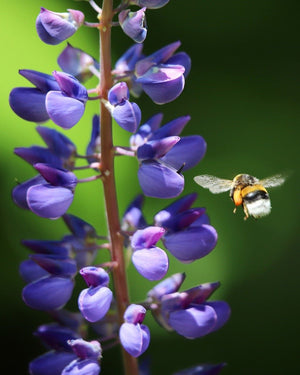
CARE
- Watering: Once established, Baptisia requires minimal watering. Water only during prolonged droughts.
- Fertilizing: Does not require fertilization due to its ability to fix nitrogen in the soil.
- Pruning: Deadheading is unnecessary, but spent flower stalks can be removed for tidiness. Cut back stems in late fall or early spring to refresh the plant.
- Pests & Diseases: Virtually pest-free. Rarely affected by deer or rabbits due to its bitter-tasting foliage.
- Dividing: Baptisia develops deep taproots, making division difficult. It is best left undisturbed once planted.
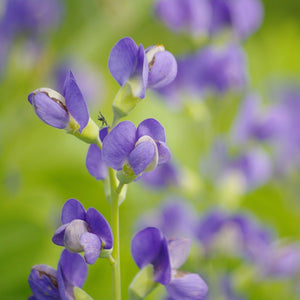
HOW TO USE
Baptisia’s bold flowers, architectural form, and easy-care nature make it a standout in many garden settings:
- Native Plant Gardens: Supports pollinators and enhances biodiversity.
- Prairie & Meadow Plantings: Thrives in naturalistic landscapes alongside grasses and wildflowers.
- Borders & Specimen Plantings: Adds a striking focal point with its upright growth and colorful blooms.
- Drought-Tolerant Gardens: Ideal for low-water landscapes and xeriscaping.
- Cut Flower Gardens: Seed pods and flowers add interest to fresh or dried floral arrangements.
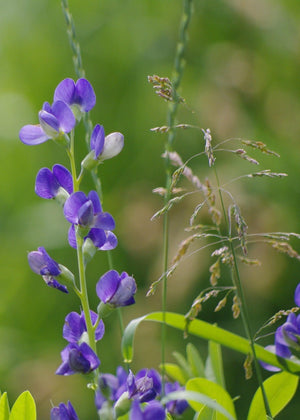
Common Questions
- How to grow Baptisia from seed? Sow seeds in fall for natural stratification or refrigerate for 8-10 weeks before spring planting. Germination can be slow, but patience is key.
- Is Baptisia deer resistant? Yes, Baptisia is highly deer-resistant due to its unpalatable foliage.
- Do you cut back Baptisia in the fall? Cutting back is optional. Some gardeners leave stems for winter interest and cut them back in early spring.
- When do Baptisia bloom? Blooms in late spring to early summer, typically for 3-6 weeks.
- Can you divide Baptisia? Baptisia has deep taproots and does not respond well to division. It is best propagated from seed or cuttings.
- Do rabbits eat Baptisia? No, rabbits typically avoid Baptisia due to its bitter foliage.
- Does Baptisia spread? Baptisia forms large clumps over time but does not aggressively spread or become invasive.
- How big does Baptisia get? Depending on the variety, mature plants reach 3-5 feet tall and wide.
- How long does Baptisia bloom? Flowering lasts between 3-6 weeks, depending on the species and environmental conditions.
Conclusion
Baptisia is a hardy, long-lived perennial that offers stunning floral displays and requires little maintenance. Whether used in native plantings, drought-tolerant gardens, or as a striking specimen plant, Baptisia provides reliable color and texture year after year. With selections like Baptisia 'Dark Chocolate', Baptisia 'Solar Flare', and Baptisia 'Violet Dusk', there is a Baptisia variety suited for every landscape. Explore our collection and enjoy the beauty of this resilient, easy-to-grow perennial.
The Baptisia Collection
Sold Out
Sold Out
Sold Out

